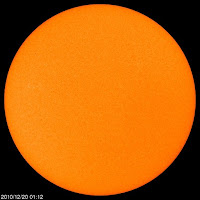 The lack of sunspot activity seems to support predictions of cold temperatures? Anthony Watts, in an article at Watts Up With That?, predicts a repeat of a Dalton Minimum. Watts recaps solar cycle expert David Archibald's graphs. What is a Dalton Minimum and its weather implications? "The Dalton Minimum was a period of low solar activity, named after the English meteorologist John Dalton, lasting from about 1790 to 1830. Like the Maunder Minimum and Spörer Minimum, the Dalton Minimum coincided with a period of lower-than-average global temperatures. The Oberlach Station in Germany, for example, experienced a 2.0°C decline over 20 years. The Year Without a Summer, in 1816, also occurred during the Dalton Minimum," writes Watts. Archibald also examines interplanetary magnetic field strength. A weaker interplanetary magnetic field means more cosmic rays reach our planet. The measure is taken by a neutron count and it is higher than the previous solar minimum. It seems, yet, another blow delivered to the global warming agenda. This is your solarcast for late 2010.
The lack of sunspot activity seems to support predictions of cold temperatures? Anthony Watts, in an article at Watts Up With That?, predicts a repeat of a Dalton Minimum. Watts recaps solar cycle expert David Archibald's graphs. What is a Dalton Minimum and its weather implications? "The Dalton Minimum was a period of low solar activity, named after the English meteorologist John Dalton, lasting from about 1790 to 1830. Like the Maunder Minimum and Spörer Minimum, the Dalton Minimum coincided with a period of lower-than-average global temperatures. The Oberlach Station in Germany, for example, experienced a 2.0°C decline over 20 years. The Year Without a Summer, in 1816, also occurred during the Dalton Minimum," writes Watts. Archibald also examines interplanetary magnetic field strength. A weaker interplanetary magnetic field means more cosmic rays reach our planet. The measure is taken by a neutron count and it is higher than the previous solar minimum. It seems, yet, another blow delivered to the global warming agenda. This is your solarcast for late 2010.
Monday, December 27, 2010
your solarcast: dalton minimum repeat
 The lack of sunspot activity seems to support predictions of cold temperatures? Anthony Watts, in an article at Watts Up With That?, predicts a repeat of a Dalton Minimum. Watts recaps solar cycle expert David Archibald's graphs. What is a Dalton Minimum and its weather implications? "The Dalton Minimum was a period of low solar activity, named after the English meteorologist John Dalton, lasting from about 1790 to 1830. Like the Maunder Minimum and Spörer Minimum, the Dalton Minimum coincided with a period of lower-than-average global temperatures. The Oberlach Station in Germany, for example, experienced a 2.0°C decline over 20 years. The Year Without a Summer, in 1816, also occurred during the Dalton Minimum," writes Watts. Archibald also examines interplanetary magnetic field strength. A weaker interplanetary magnetic field means more cosmic rays reach our planet. The measure is taken by a neutron count and it is higher than the previous solar minimum. It seems, yet, another blow delivered to the global warming agenda. This is your solarcast for late 2010.
The lack of sunspot activity seems to support predictions of cold temperatures? Anthony Watts, in an article at Watts Up With That?, predicts a repeat of a Dalton Minimum. Watts recaps solar cycle expert David Archibald's graphs. What is a Dalton Minimum and its weather implications? "The Dalton Minimum was a period of low solar activity, named after the English meteorologist John Dalton, lasting from about 1790 to 1830. Like the Maunder Minimum and Spörer Minimum, the Dalton Minimum coincided with a period of lower-than-average global temperatures. The Oberlach Station in Germany, for example, experienced a 2.0°C decline over 20 years. The Year Without a Summer, in 1816, also occurred during the Dalton Minimum," writes Watts. Archibald also examines interplanetary magnetic field strength. A weaker interplanetary magnetic field means more cosmic rays reach our planet. The measure is taken by a neutron count and it is higher than the previous solar minimum. It seems, yet, another blow delivered to the global warming agenda. This is your solarcast for late 2010.
Labels:
dalton minimum,
david archibald,
maunder minimum,
solar,
sporer minimum,
sunspots
Subscribe to:
Post Comments (Atom)
The year without a summer during the Dalton Minimum had a great helping hand from the eruption of Mount Tambora on April 10, 1815. The following summer, the world temperatures had dropped about 0.7-1.3 degrees F. Note other volcanoes had previously erupted (VEI-level 4 force) in the Caribbean, Indonesia, Japan, and the Philippines. Volcanic eruptions do tend to increase during grand solar minimums like Dalton.
ReplyDelete